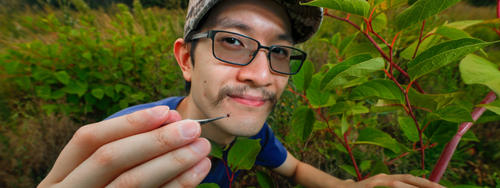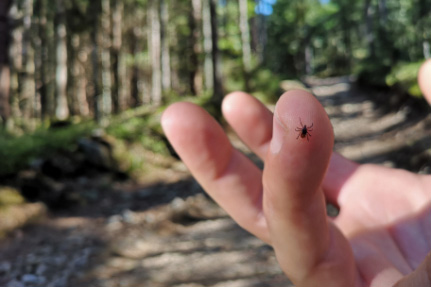
Benedict Khoo: Targeting tickborne diseases
For Benedict Khoo, making a breakthrough discovery in health-related research doesn’t mean much if it can’t be put to use bettering people’s lives.
For Benedict Khoo, making a breakthrough discovery in health-related research doesn’t mean much if it can’t be put to use bettering people’s lives.
He knows from experience. When he worked in a research lab in Ohio, he felt “divorced from having a tangible impact,” due largely to regulatory hurdles in the field.
But that all changed when he turned to public health. There, he says, however his work turns out, he learns something that could help people make their own health decisions or influence policies.
“That’s what drove me—to have that impact on the world and feel like I’m doing something,” says Khoo, a doctoral student in the School of Public Health (SPH).
He found his niche with Jonathan Oliver, an assistant professor of environmental health sciences in SPH, who is now his adviser. Together they study the prevalence of Lyme disease and other tickborne diseases of humans, in a study area comprising Minnesota and adjacent northern Iowa and western Wisconsin.
Pathogen sleuths
In a two-year survey, Khoo collected ticks from forests and fields. Back in Oliver’s lab, he’s analyzing them to see if they carry bacterial pathogens like Borrelia burgdorferi, the causal agent of Lyme disease.
If a tick carries any such infectious bacterial strains, they will turn up in the tick’s microbiome. To find those bacteria, Khoo and fellow researchers look for telltale DNA sequences among the myriad in the microbiome. And with success.
“We’ve definitely found lots of Lyme disease bacteria,” he notes.
Data on where and when all the host ticks were collected will go into a database from which a map of Upper Midwest pathogen prevalences will be constructed. Khoo hopes the map will give people a better chance of avoiding the infected ticks. He expects to soon publish a paper on the survey results.
“We can relate pathogens to geographic areas, but we need a better grasp on this,” he says. “This is a relatively large dataset that we’ve compiled, but one survey shouldn’t be counted on to correctly inform any decision. We really require a lot more.”
Hikers beware
While Khoo says people returning from a hike anywhere should check themselves for ticks, he wants to give the public “a bit more fine, granular information” to help them avoid trouble up front.
That’s one area where a publicly available map of regional tickborne pathogen prevalence could make a difference. For example, suppose people wanted to take kids and dogs to a state park, but they learn it has a high prevalence of pathogens.
“In that case, because both kids and dogs are hard to check for ticks, they [might] decide to take them to a different site with less pathogen prevalence,” Khoo says.


Tick delivery trucks
Both deer and deer ticks thrive in transitional environments, says Khoo, and one hypothesis links the spread of ticks and Lyme disease in the Upper Midwest to the rise and fall of farms in this part of the country.
“Farming knocked out woods,” he explains. “But some farms went fallow, and trees cropped up again, creating little islands of woods for deer. Ticks would hitch a ride on the deer, feeding as they went, then drop off the deer at [a new] island.
“These little isolated, fragmented woods were the perfect way for ticks to hopscotch their way and spread, using deer as a delivery truck.”
Just the beginning
Controlling tickborne diseases will involve not only scientists like Khoo and Oliver, but government health departments, forestry and wildlife agencies, and veterinarians. With approximately 476,000 Americans being diagnosed and treated for Lyme disease each year—though some may not actually have the disease—lowering the infection rate will reduce illness and associated medical costs.
Khoo says his work exemplifies the One Health focus on multidisciplinary systems and, in his case, the triangle of host (deer, human, or other mammal), vector (ticks) and disease. And while much is known about tickborne diseases in humans, little is known about the ticks and tick populations across the United States.
“You may be able to stamp out a disease in humans,” says Khoo. “But,” he warns, “until you get rid of it in animals, it’s just going to come back.”
- Categories:
- Health





